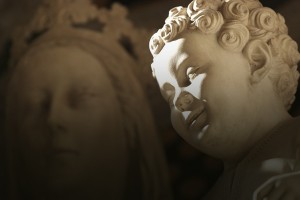
Then will Allah say: “O Jesus the son of Mary! Recount My favour to thee and to thy mother. Behold! I strengthened thee with the holy spirit, so that thou didst speak to the people in childhood and in maturity. Behold! I taught thee the Book and Wisdom, the Law and the Gospel and behold! thou makest out of clay, as it were, the figure of a bird, by My leave, and thou breathest into it and it becometh a bird by My leave, and thou healest those born blind, and the lepers, by My leave. And behold! thou bringest forth the dead by My leave. And behold! I did restrain the Children of Israel from (violence to) thee when thou didst show them the clear Signs, and the unbelievers among them said: ‘This is nothing but evident magic.’ (Qur’an, Surah 005.110)
Where did the Quran get this information about Jesus? It seems to come from a single pseudepigraphical gospel called the Infancy Gospel of Thomas. This ancient text is attributed to an author named “Thomas the Israelite” and it provides a number of stories related to the miraculous childhood of Jesus, chronicling the years missing in the canonical gospel of Luke. The Infancy Gospel of Thomas describes Jesus performing the very miracles mentioned in the Quran, along with additional mischievous (sometimes mean-spirited) supernatural acts. The pseudepigraphical gospel was popular in North African Coptic Christian communities and would certainly have been familiar to the author of Surah 5. For this reason, the Infancy Gospel of Thomas is most reasonably the source for the material in the Quran.
But there are many reasons to reject this portrayal of Jesus’ childhood. The Infancy Gospel was written well after the canonical Gospels (150-185AD) and the author seems unfamiliar with the Jewish life and customs of the 1st century. The text also presupposes the Gospel of Luke and must, therefore, have been written after Luke’s text was distributed and well known; the author is dependent upon Luke for his information related to the life of Jesus, the Sabbath and the Passover. It also appears that the early Church Fathers were aware of this late gospel and identified it as errant. Irenaeus appears to refer to it and includes it in his list of unreliable non-canonical documents described in “Against Heresies” (180AD). Hippolytus and Origen also refer to a Gospel of Thomas in their respective lists of heretical books (although it is unknown if they are referring to this text or the “sayings” Gospel of Thomas).
But there’s an even better reason to reject the claims of the Infancy Gospel of Thomas: They are in contradiction to the clear teaching of the reliable accounts from Luke and John. There is more than enough reason to trust the historicity of the canonical Gospels (I’ve described this evidence in depth in Cold-Case Christianity) and these trustworthy accounts directly contradict the claims of the Infancy Gospel. Luke, in the 4th chapter of his Gospel, describes the inhabitants of Nazareth responding in shock to Jesus’ initial messianic teaching. They seemed wholly unfamiliar that Jesus could be anything more than a common son of a carpenter. The Infancy Gospel of Thomas, however, describes Jesus as a brilliant child who performed a number of public miracles in Nazareth. Perhaps more importantly, John specifically tells us that Jesus first public “sign” (miracle) was performed at the wedding in Cana when Jesus turned water into wine (John 2:1-11). While the Infancy Gospel and the Quran claim that Jesus showed people “the clear Signs” throughout his childhood years, the reliable eyewitnesses accounts describe something very different. The best and most reasonable inference from the ancient historical record related to Jesus is that He waited until his public ministry (as an adult) to reveal His power. Click To Tweet
The best and most reasonable inference from the ancient historical record related to Jesus is that He waited until his public ministry (as an adult) to reveal His power to His disciples and the world He came to save. Jesus did not perform miracles as a child.

J. Warner Wallace is a Dateline featured Cold-Case Detective, Senior Fellow at the Colson Center for Christian Worldview, Adj. Professor of Christian Apologetics at Talbot School of Theology, Biola University, author of Cold-Case Christianity, God’s Crime Scene, and Forensic Faith, and creator of the Case Makers Academy for kids.
Subscribe to J. Warner’s Daily Email
Save
J. Warner Wallace is a Dateline featured cold-case homicide detective, popular national speaker and best-selling author. He continues to consult on cold-case investigations while serving as a Senior Fellow at the Colson Center for Christian Worldview. He is also an Adj. Professor of Christian Apologetics at Talbot School of Theology, Biola University, and a faculty member at Summit Ministries. He holds a BA in Design (from CSULB), an MA in Architecture (from UCLA), and an MA in Theological Studies (from Gateway Seminary).







































Pingback: Jesus’ Words Gave Him Away | Cold Case Christianity
Pingback: How Can We Trust the Gospels When the Genealogies Are So Different? | Cold Case Christianity
Pingback: The Early “High Christology” of Jesus | Cold Case Christianity
Pingback: Why I Know the Story of Jesus Wasn’t Changed Over Time | Cold Case Christianity
Pingback: The Deity of Jesus is Not a Late Legend | Cold Case Christianity
Pingback: How Can We Trust the Gospels When the Genealogy of Jesus Is So Different? | TLG Christian News
Pingback: The Essence Of Miracles
Pingback: Midweek Apologetics Roundup - Hope's Reason
Pingback: Quarantine Bible Study: “The Beginning” – Mark 1:1-8 | Elliot's Blog
Gerald McDonald
February 18, 2023 at 9:30 am
Has this author ever done any research as to how the Sabbath was supposedly changed from the 7th day of the week to the 1st day.
It would seem unlikely that God would not give a direct quote to the disciples for them to leave in His Word letting us know of such a change.